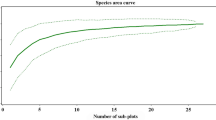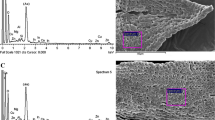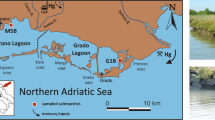Abstract
Bryophytes with high As accumulation affinity were identified in the aquatic environment. We surveyed a stream near copper mine tailings and then conducted laboratory experiments to confirm As accumulation in the bryophytes with high As affinity. We found that a moss, Scopelophila cataractae, accumulates As in addition to Cu in aquatic environments and confirmed it in laboratory experiments. The highest value for As in S. cataractae from the field survey was 1300 mg/kg dry weight at relatively low As concentrations in the stream water (0.005 mg/L). In addition, Brachythecium plumosum and Rhynchostegium riparioides may also be useful bryophytes for accumulation of Cu and As, though the mechanisms of As accumulation might differ between these two bryophytes and S. cataractae.
Zusammenfassung
Bryophyten mit Neigung zu hoher As-Akkumulation wurden in einem aquatischen Ökosystem identifiziert. Die Untersuchungen konzentrierten sich auf ein Oberflächengewässer in unmittelbarer Nähe zu abgelagerten Rückständen aus der Kupfer-Aufbereitung. Die anschließenden Laborexperimente zielten auf die Bestätigung einer As-Anreicherung innerhalb der As-affinen Bryophyten. Es zeigte sich, dass eines der Moose, Scopelophila cataractae, in der Lage ist, As zusätzlich zu Cu zu akkumulieren, was sich in den Laborexperimenten bestätigte. Aus den Felduntersuchungen wurden in S. cataractae maximale As-Konzentrationen von 1.300 mg/kg Trockenmasse gefunden, und dies bei relativ niedrigen As-Konzentrationen im Oberflächenwasser (0,005 mg/L). Darüber hinaus erwiesen sich Brachythecium plumosum und Rhynchostegium riparioides als für die Cu- und As-Akkumulation ebenfalls nutzbare Bryophyten, wobei sich bei diesen beiden Arten die für die As-Akkumulation verantwortlichen Mechanismen möglicherweise von den bei S. cataractae auftretenden unterscheiden.
Resumen
Se identificaron briófitas en ambiente acuático con alta afinidad para acumular arsénico. Se realizaron estudios en una corriente cerca de las colas de una mina de cobre y luego se condujeron experimentos en laboratorio para confirmar la acumulación de As en la briófitas con alta afinidad por As. Se encontró que un musgo, Scopelophila cataractae, acumula As junto a Cu en ambientes acuáticos y luego confirmado en experimentos de laboratorio. El mayor valor de As en S. cataractae en los estudios de campo fue 1.300 mg/kg peso seco a relativamente bajas concentraciones de As en el agua de la corriente (0005 mg/L). Además, las briófitas Brachythecium plumosum y Rhynchostegium riparioides también pueden ser útiles para la acumulación de Cu y As, aunque sus mecanismos de acumulación de As podrían diferir con los que tiene S. cataractae.
摘要
具有As累积效应的苔藓植物往往生存于水生环境。我们沿铜矿尾矿库附近的一条小溪进行调查并通过室内实验证实了苔藓植物的砷(As)亲和能力。研究发现一种叫剑叶舌叶藓(Scopelophila cataractae)的苔藓能够积聚除铜(Cu)之外的水生环境中的砷(As),并通过室内实验证实了这一发现。剑叶舌叶藓(S.cataractae)野外干燥样品中砷(As)的最大含量为1300 mg/kg(干重),而水环境中砷(As)的浓度仅0.005 mg/L。另外,羽枝青藓(Brachythecium plumosum)和水生长喙藓(Rhynchostegium riparioides)也是具有铜(Cu)、砷(As)累积效应的苔藓植物,但是这两种藓类植物与剑叶舌叶藓的砷(As)累积机理可能不尽相同。


Similar content being viewed by others
References
Aikawa Y, Nagano I, Sakamoto S, Nishiyama M, Matsumoto S (1999) Contents of heavy metal elements in copper mosses: Scopelophila ligulata, Scopelophila cataractae, and Mielichhoferia japonica and their substrates. Soil Sci Plant Nutr 45:835–842
Arao T, Ishikawa S, Murakami M, Abe K, Maejima Y, Makino T (2010) Heavy metal contamination of agricultural soil and countermeasures in Japan. Paddy Water Environ, 8:247–257
Bakar AFA, Yusoff I, Fatt NT, Othman F, Ashraf MA (2013) Arsenic, zinc, and aluminium removal from gold mine wastewater effluents and accumulation by submerged aquatic plants (Cabomba piauhyensis, Egeria densa, and Hydrilla verticillata). BioMed Res Int. doi:10.1155/2013/890803 Article ID 890803
Bhattacharya P, Welch AH, Stollenwerk KG, McLaughlin MJ, Bundschuh J, Panaullah G (2007) Arsenic in the environment: biology and chemistry. Sci Total Environ 379:109–120
Brooks RR (1998) Plants that hyperaccumulate heavy metals. CABI, Oxfordshire
Carginale V, Sorbo S, Capasso C, Trinchella F, Cafiero G, Basile A (2004) Accumulation, localisation, and toxic effects of cadmium in the liverwort Lunularia cruciata. Protoplasma 223:53–61
Carrier P, Baryla A, Havaux M (2003) Cadmium distribution and microlocalization in oilseed rape (Brassica napus) after long-term growth on cadmium-contaminated soil. Planta 216:939–950
Favas PJC, Pratas J, Prasad MNV (2012) Accumulation of arsenic by aquatic plants in large-scale field conditions: opportunities for phytoremediation and bioindication. Sci Total Environ 433:390–397
Fukui prefecture (1994) Fukuiken-shi. http://www.archives.pref.fukui.jp/fukui/07/kenshi/T5/T5-00.htm
Guimaraes FP, Aguiar R, Oliveira JA, Silva JAA, Karam D (2012) Potential of macrophytes for removing arsenic from aqueous solution. Planta Daninha 30:683–696
Itouga M, Kato Y, Yamaguchi I, Ono Y, Sakakibara H (2005) Phytoremediation using bryophytes, 1: characterization of copper accumulation and remediation of lead from fry ash using Scopelophila cataractae (Mitt.) Broth. Hikobia 14:263–271 [in Japanese]
Japanese Ministry of Environment (2013) Monitoring reports of Japanese public water quality in 2012. http://www.env.go.jp/water/suiiki/h24/full.pdf
Koide R, Tokoro C, Murakami S, Adachi T, Takahashi A (2012) A model for prediction of neutralizer usage and sludge generation in the treatment of acid mine drainage from abandoned mines: case studies in Japan. Mine Water Environ 21:287–296
Konno H, Nakashima S, Katoh K (2010) Metal-tolerant moss Scopelophila cataractae accumulates copper in the cell wall pectin of the protonema. J Plant Phys 167:358–364
Krzeslowska M, Lenartowska M, Mellerowicz EJ, Samardakiewicz S, Wozny A (2009) Pectinous cell wall thickenings formation—a response of moss protonemata cells to lead. Environ Exp Bot 65:119–131
Litter MI, Morgada ME, Bundschuh J (2010) Possible treatments for arsenic removal in Latin American waters for human consumption. Environ Poll 158:1105–1118
Ma LQ, Komar KM, Tu C, Zhang WH, Cai Y, Kennelley ED (2001) A fern that hyperaccumulates arsenic. Nature 409:579
Meharg AA, Macnair MR (1994) Relationship between plant phosphorus and the kinetics of arsenate influx in clones of Deschampsia cespitosa (L.) Beauv that differ in their tolerance to arsenate. Plant Soil 162:99–106
Mohan D, Pittman CU (2007) Arsenic removal from water/wastewater using adsorbents—a critical review. J Hazard Mater 142:1–53
Prasad MNV, Freitas HMD (2003) Metal hyperaccumulation in plants—biodiversity prospecting for phytoremediation technology. Electro J Biotech 6:285–321
Pulford ID, Watson C (2003) Phytoremediation of heavy metal-contaminated land by trees—a review. Environ Int 29:529–540
Robinson B, Kim N, Marchetti M, Moni C, Schroeter L, Dijssel CVD, Milne G, Clothier B (2006) Arsenic hyperaccumulation by aquatic macrophytes in the Taupo Volcanic Zone, New Zealand. Environ Exp Bot 58:206–215
Ruiz-Chancho MJ, Lopez-Sanchez JF, Schmeisser E, Goessler W, Francesconi KA, Rubio R (2008) Arsenic speciation in plants growing in arsenic-contaminated sites. Chemosphere 71:1522–1530
Sardans J, Peñuelas J (2006) Introduction of the factor of partitioning in the lithogenic enrichment factors of trace element bioaccumulation in plant tissues. Environ Monit Assess 115:476–498
Satake K, Shibata K, Nishikawa M, Fuwa K (1988) Copper accumulation and location in the moss Scopelophila cataractae. J Bryol 15:353–376
Satake K, Nishikawa M, Shibata K (1990) A copper-rich protpnemal colony of the moss Scopelophila cataractae. J Bryol 16:109–116
Sen Gupta B, Chatterjee S, Rott U, Kauffman H, Bandopadhyay A, DeGroot W, Nag NK, Carbonell-Barrachina AA, Mukherjee S (2009) A simple chemical free arsenic removal method for community water supply—a case study from West Bengal. India Environ Pollut 157:3351–3353
Shaw AJ (1995) Genetic biogeography of the rare copper-moss, Scopelophila cataractae (Pottiaceae). Plant Syst Evol 197:43–58
Tripathi RD, Srivastava S, Mishra S, Singh N, Tuli R, Gupta DK, Maathuis FJM (2007) Arsenic hazards: strategies for tolerance and remediation by plants. Trends Biotech 25:158–165
Ullrich-Eberius CI, Sanz A, Novacky AJ (1989) Evaluation of arsenate- and vanadate-associated changes of electrical membrane potential and phosphate transport in Lemna gibba G1. J Exp Bot 40:119–128
Vithanage M, Dabrowska BB, Mukherjee AB, Sandhi A, Bhattacharya P (2012) Arsenic uptake by plants and possible phytoremediation applications: a brief overview. Environ Chem Lett 10:217–224
Zheng YQ, Dai XJ, Wang L, Xu WZ, He ZY, Ma M (2008) Arsenate reduces copper phytotoxicity in gametophytes of Pteris vittata. J Plant Phys 165:1906–1916
Author information
Authors and Affiliations
Corresponding author
Rights and permissions
About this article
Cite this article
Suzuki, Y., Takenaka, C., Tomioka, R. et al. Accumulation of Arsenic and Copper by Bryophytes Growing in an Aquatic Environment near Copper Mine Tailings. Mine Water Environ 35, 265–272 (2016). https://doi.org/10.1007/s10230-015-0335-7
Received:
Accepted:
Published:
Issue Date:
DOI: https://doi.org/10.1007/s10230-015-0335-7




